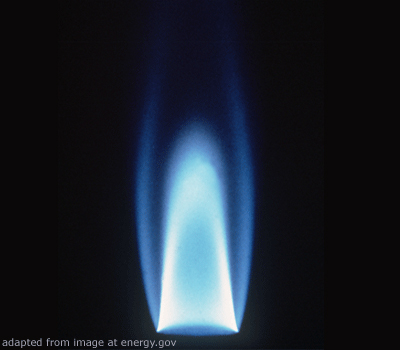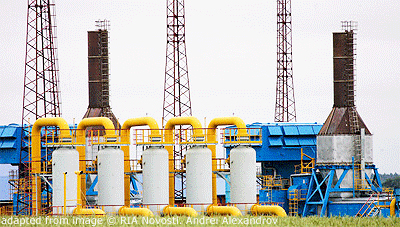Russia 2014 Gas Exports Seen Lowest in Decade as Nations Cut Use

(Bloomberg – bloomberg.com – Elena Mazneva – January 13, 2015) Russia, the world’s biggest natural-gas exporter, probably cut 2014 fuel exports to the lowest in a decade as consumption in Europe and Ukraine declined.
OAO Gazprom (GAZP), the state-run gas-pipeline export monopoly, supplied no more than 195 billion cubic meters of fuel from Russia to the European Union, Turkey and the Commonwealth of Independent States, according to UBS AG estimates. That’s about 10 percent less than in 2013. Total exports were about 192 billion cubic meters last year, according to Bloomberg calculations based on daily data from European pipeline operators.
 “The EU and Ukraine’s policy to reduce dependence on Russian gas is giving fruit,” said Maxim Moshkov, a Moscow-based oil and gas analyst at UBS. “Gazprom won’t seriously ramp up its supplies in the medium term — at least until it starts the export to China in 2019 to 2020.”
“The EU and Ukraine’s policy to reduce dependence on Russian gas is giving fruit,” said Maxim Moshkov, a Moscow-based oil and gas analyst at UBS. “Gazprom won’t seriously ramp up its supplies in the medium term — at least until it starts the export to China in 2019 to 2020.”
Facing its first recession since 2009, Russia relies on natural gas for 11 percent to 12 percent of its total export revenue. The EU is Gazprom’s key earnings market, while Ukraine was previously the largest gas importer in the CIS. Both regions are reducing gas consumption and seeking to ease reliance on Russia as relations soured over its annexation of Crimea and the conflict in eastern Ukraine.
While Gazprom’s share in the EU market is seen unchanged at about 30 percent, the 28-nation bloc trimmed its gas consumption 9 percent last year, the fourth annual drop, according to a forecast by Brussels-based lobby group Eurogas.
Further Weakness
Demand for Russian gas by the EU is bound to weaken further due to the unfavorable economic environment, as well as an improvement in energy efficiency in some countries, Georgi Slavov, head of basic resources research at brokerage Marex Spectron Group in London, said by e-mail.
“None of the above has anything to do with the ongoing political situation, but clearly some countries are also ready to pay a premium in order to diversify their energy-supply chain,” Slavov said. “The result is an increase in LNG imports and improved cross-border connectivity within the EU28.”
Still, Gazprom may choose to make use of its cost advantage, Simon Pirani, a senior research fellow at the Oxford Institute for Energy Studies, said by phone. “Gazprom has more gas which it can get to Europe at a lower cost than any other producer, that remains the case. And so it could — if it chose — compete.”
Cut Imports
Ukraine cut gas imports from Russia 44 percent to 14.5 billion cubic meters last year, according to its national pipeline operator. That’s the lowest level of supplies from Gazprom or its associated companies since at least 1999.
“This year, Gazprom lost half of its market in Ukraine. Next year they may lose up to 80 percent,” Andriy Kobolyev, chief executive officer of Ukraine’s Naftogaz Ukrainy, said in December.
Gazprom’s press service declined to comment on 2014 exports and future estimates.
Ukraine’s gas imports will depend on consumption and terms of supply, Naftogaz spokeswoman Aliona Osmolovska said, without elaborating. The country has been boosting gas deliveries from EU companies, including fuel originally produced in Russia, since the middle of last year as former Soviet republics dispute gas prices and debt payments.
Gazprom and Naftogaz signed an interim price agreement through March and will continue their dispute in Stockholm arbitration after the heating season ends.
Diversification Policy
Ukraine will try its best not to increase gas imports from Gazprom, according to Pirani. “Even if Russian gas molecules go first to central Europe and then are sold to Ukraine on a reverse-flow basis, direct sales under the Naftogaz contract are going to fall because Ukraine will pursue its policy to diversify away from Russian gas as much as it can.”
Russia’s average gas price in Europe may decline to about $275 per 1,000 cubic meters this year from $361 expected for 2014 because of slumping crude, according to Moshkov. Almost half of Europe’s wholesale gas contracts are linked to oil, with the impact showing up with a lag of six to nine months.
Brent fell 3.3 percent to $45.86 a barrel on the London-based ICE Futures Europe exchange at 1:25 p.m. in the city, trading near the lowest level in more than 5 1/2 years.
Gazprom will probably face “a negative earnings dynamics in the mid-term,” said Ildar Davletshin, an oil and gas analyst at Renaissance Capital in Moscow.
Dividend Forecast
The company’s dividend, based on 2014 results, may decline 40 percent to 4.3 rubles a share, “although much depends on treatment of provisions in the fourth quarter results,” Davletshin said.
The company may see more demand abroad this year, particularly if European weather gets a bit colder, according to Trevor Sikorski, head of gas, coal and carbon at London-based consultants Energy Aspects Ltd.
“But, it will be increasingly challenged for market share as LNG returns,” Sikorski said. “It might be able to expand exports but will have to do so at a lower price.”
Gazprom said last year that Turkey, its biggest export market after Germany, is a real alternative for Russia to increase gas sales abroad due to the Black Sea state’s rising needs “The Turkish gas market is growing but is relatively small,” Sikorski said.
Gazprom transferred 65.4 billion rubles ($1 billion) of dividends directly to the state last year. That’s the highest single income source for the government as it faces a 4.5 percent contraction in the economy this year with oil at $60 per barrel, according to central bank estimates on Dec. 15.
Article ©2015 Bloomberg L.P. All Rights Reserved. Article also appeared at bloomberg.com/news/2015-01-13/russia-2014-gas-exports-seen-lowest-in-decade-as-nations-cut-use.html
